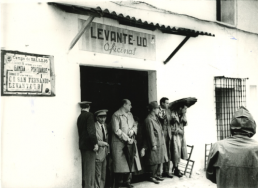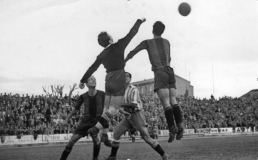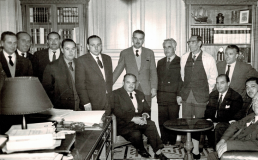Headquarters of Levante U.D. in Vallejo
In June 1941, the UDLG definitively became Levante U.D. The blue and red colours, characteristic of Gimnástico, returned to the shirts and the Levante name was highlighted. Vallejo, purchased as a property by Antonio Román in the early fifties, remained as their home ground.
Levante U.D. players challenging for the ball in the Vallejo Stadium
The self-sufficient forties proved to be a continuous surge forward. Despite coming close to promotion to the First Division to start with, UDLG stayed down; economic crises followed one after another, calling into question the stability of the club. From a sporting perspective, the club, baptised as Levante U.D. since June 1941 and resuming the Gimnástico colours, navigated between the Second and Third Divisions with a brief stay in the regional category during a period when the Third Division was cancelled. In the second half of the decade the team managed to stabilise as a member of the Silver category. There were epic moments in that decade. Dolz’s Levante put Athletic Club’s capacity for resistance to the test in a titanic play off for the Copa del Generalísimo.
The families that bought Vallejo
The fifties emerged in a haze. Levante had been playing their matches in Vallejo since Gimnástico had leased, in the mid-1920s, land belonging to the Martínez de Vallejo family. The owners of this land decided to revoke the established arrangement, posing a serious problem with a very complex solution for the club’s representatives.
Levante suffered the consequences and were evicted. From a procedural perspective, this terrible setback coincided with the start of the first stage of Antonio Román being at the helm of the club. The president soon discovered the key to finding answers to the problem arising from this horrendous situation.
As an essential measure, Antonio Román dodged the dramatic effects of this impediment to survival by going on the counterattack and venturing on the purchase of a facility that would revert to being an asset for an organisation dispossessed of such a property. The operation, estimated at around five million pesetas, was paid for by issuing membership passes for fifteen years, while the rest of the capital came from an investment made by businessmen enlisted for the cause by the president. (In the photo, Antonio Román and the families that managed to purchase the terrain on Calle de Alboraya).
Campo de Vallejo with the Carmelite Convent in the background
With the acquisition of Vallejo as the cornerstone of his project, Antonio Román tried to push Levante forward, despite the never-ending financial problems. He always defended the prosperity of this initiative achieved before the attraction generated by increasing his properties. Román modernised the internal structure of the club. The president had to deal with the effects of the 1957 flood that devastated the city. Football-wise, after fluctuating between the Second and Third Division, the Levante squad managed to establish itself in the Silver category and even battled for promotion to the First Division. That chance of promotion was a game played against Las Palmas in the 1958-1959 season, a dream that faded.
Those were the times of Wilkes, a historic signing, Paredes and Joseíto, among other upcoming footballers. The decade of the fifties ended with Román defending the construction of a new, more modern and practical stadium that would take over from Vallejo. The construction of the current Ciutat de València was beginning to be perceived, although its construction was to take a long time.



